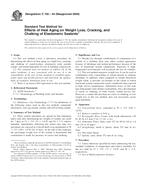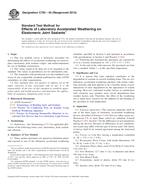We need your consent to use the individual data so that you can see information about your interests, among other things. Click "OK" to give your consent.
ASTM C1472-10
Standard Guide for Calculating Movement and Other Effects When Establishing Sealant Joint Width
STANDARD published on 1.6.2010
The information about the standard:
Designation standards: ASTM C1472-10
Note: WITHDRAWN
Publication date standards: 1.6.2010
SKU: NS-11426
The number of pages: 21
Approximate weight : 63 g (0.14 lbs)
Country: American technical standard
Category: Technical standards ASTM
The category - similar standards:
Annotation of standard text ASTM C1472-10 :
Keywords:
bridge joint, butt joint, construction tolerance, expansion joint, fillet joint, moisture movement, performance factor, sealant, sealant backing, sealant joint design, thermal movement, Sealants, Calculating test values, Movement calculation, Sealant joint width, ICS Number Code 91.100.50 (Binders. Sealing materials)
Additional information
| Significance and Use | ||||||||||||||||||||||||||||
|
Design professionals, for aesthetic reasons, have desired to limit the spacing and width of sealant joints on exterior walls and other locations of new buildings. Analysis of the performance factors and especially tolerances that affect a sealant joint is necessary to determine if a joint will have durability and be effective in maintaining a seal against the passage of air and water and not experience premature deterioration. If performance factors and tolerances are not understood and included in the design of a sealant joint, then the sealant may reach its durability limit and failure is a distinct possibility. Sealant joint failure can result in increased building energy usage due to air infiltration or exfiltration, water infiltration, and deterioration of building systems and materials. Infiltrating water can cause spalling of porous and friable building materials such as concrete, brick, and stone; corrosion of ferrous metals; and decomposition of organic materials, among other effects. Personal injury can result from a fall incurred due to a wetted interior surface as a result of a failed sealant joint. Building indoor air quality can be affected due to organic growth in concealed and damp areas. Deterioration is often difficult and very costly to repair, with the cost of repair work usually greatly exceeding the original cost of the sealant joint work. This guide is applicable to sealants with an established movement capacity, in particular elastomeric sealants that meet Specification C920 with a minimum movement capacity rating of ± 12½ percent. In general, a sealant with less than ± 12½ percent movement capacity can be used with the joint width sizing calculations; however, the width of a joint using such a sealant will generally become too large to be practically considered and installed. It is also applicable to precured sealant extrusions with an established movement capacity that meets Specification C1518. The intent of this guide is to describe some of the performance factors and tolerances that are normally considered in sealant joint design. Equations and sample calculations are provided to assist the user of this guide in determining the required width and depth for single and multi-component, liquid-applied sealants when installed in properly prepared joint openings. The user of this guide should be aware that the single largest factor contributing to non-performance of sealant joints that have been designed for movement is poor workmanship. This results in improper installation of sealant and sealant joint components. The success of the methodology described by this guide is predicted on achieving adequate workmanship. Joints for new construction can be designed by the recommendations in this guide as well as joints that have reached the end of their service life and need routine maintenance or joints that require remedial work for a failure to perform. Guide C1193 should also be consulted when designing sealant joints. Failure to install a sealant and its components following its guidelines can and frequently will result in failure of a joint design. Peer reviewed papers, published in various ASTM Special Technical Publications (STP), provide additional information and examples of sealant joint width calculations that expand on the information described in this guide (2-5). For cases in which the state of the art is such that criteria for a particular condition is not firmly established or there are numerous variables that require consideration, a reference section is provided for further consideration. To assist the user of this guide in locating specific information, a detailed listing of guide numbered sections and their headings is included in Appendix X1. |
||||||||||||||||||||||||||||
| 1. Scope | ||||||||||||||||||||||||||||
|
1.1 This guide provides information on performance factors such as movement, construction tolerances, and other effects that should be accounted for to properly establish sealant joint size. It also provides procedures to assist in calculating and determining the required width of a sealant joint enabling it to respond properly to those movements and effects. Information in this guide is primarily applicable to single- and multi-component, cold-applied joint sealants and secondarily to precured sealant extrusions when used with properly prepared joint openings and substrate surfaces. 1.2 Although primarily directed towards the understanding and design of sealant joints for walls for buildings and other areas, the information contained herein is also applicable to sealant joints that occur in horizontal slabs and paving systems as well as various sloped building surfaces. 1.3 This guide does not describe the selection and properties of joint sealants (1) , nor their use and installation, which is described by Guide C1193. 1.4 For protective glazing systems that are designed to resist blast and other effects refer to Guide C1564 in combination with this guide. 1.5 This guide is not applicable to the design of joints sealed with aerosol foam sealants. 1.6 For structural sealant glazing systems refer to Guide C1401 in combination with this guide. 1.7 The values and calculations stated in SI units are to be regarded as the standard. The values given in parentheses and inch-pound units are provided for information only. SI units in this guide are in conformance with IEEE/ASTM SI 10-1997. 1.8 The Committee having jurisdiction for this guide is not aware of any comparable standards published by other organizations. 1.9 This standard does not purport to address all of the safety concerns, if any, associated with its use. It is the responsibility of the user of this standard to establish appropriate safety and health practices and determine the applicability of regulatory limitations prior to use. |
||||||||||||||||||||||||||||
| 2. Referenced Documents | ||||||||||||||||||||||||||||
|
Similar standards:
Historical
1.5.2008
Historical
1.6.2010
Historical
1.9.2010
Historical
1.6.2014
Historical
1.5.2012
Historical
1.6.2011
We recommend:
Technical standards updating
Do you want to make sure you use only the valid technical standards?
We can offer you a solution which will provide you a monthly overview concerning the updating of standards which you use.
Would you like to know more? Look at this page.



 ASTM C792-04(2008)..
ASTM C792-04(2008).. ASTM C793-05(2010)..
ASTM C793-05(2010).. ASTM C794-10
ASTM C794-10 ASTM C834-14
ASTM C834-14 ASTM C836/C836M-12..
ASTM C836/C836M-12.. ASTM C864-05(2011)..
ASTM C864-05(2011)..
 Cookies
Cookies
